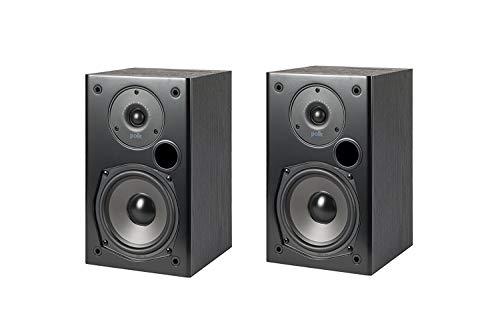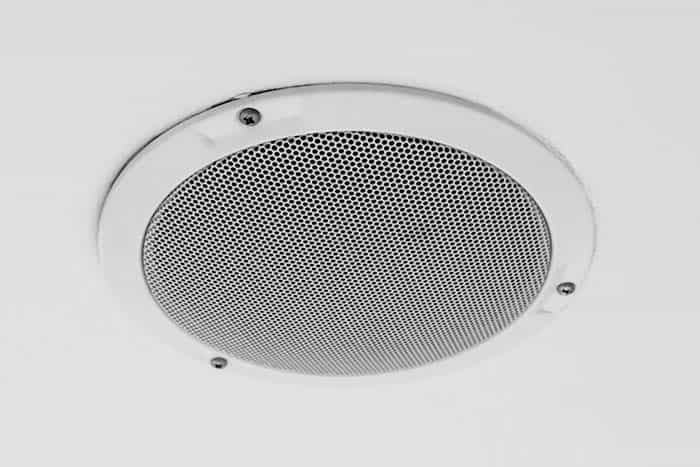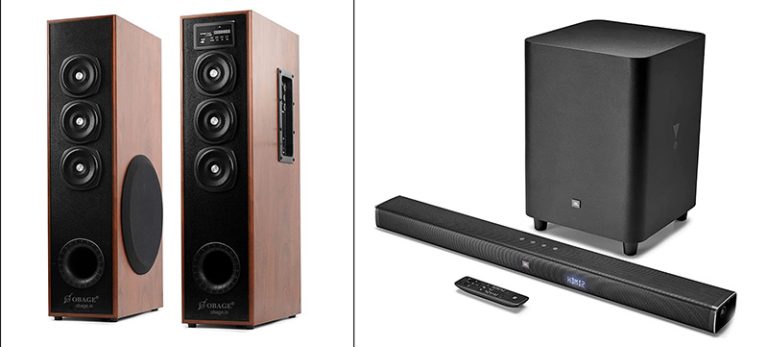Surround Vs Back Speakers – What’s the Difference?
With the wide variety of surround sound system configurations available in the market, it can be quite confusing which format to select. Should you buy a system with one pair of surround speakers?

Or should you buy one with back speakers too? What’s the difference between surround and back speakers?
Surround Vs Back Speakers
The main difference between surround and back speakers is in their placement and configuration.
Positioned on the left and right sides of the audience, surround speakers are used in 5.1 and higher systems while back speakers are placed behind the seating area and only work with 7.1 configurations and above.
Also read: How To Fix Muffled Sound From Speakers
What do surround speakers do?
Surround speakers help provide the audience with an immersive three-dimensional sound experience. Rather than the sound only coming from the front in one direction, the audience feels as if the sound is all around them. Hence the term “surround sound”.
One of the most popular configurations for surround systems is the 5.1 channel configuration. It consists of five speakers plus one subwoofer.
The primary speakers (left, right, and center) are usually placed under and on either side of the TV or screen. The two surround speakers are placed on the left and right sides of the audience or slightly behind.
While the primary speakers play the main dialogue and sound, the surround speakers provide the ambient sounds.
Depending on the number of speakers, the left and right surround speakers are placed at the sides and behind the audience. In a 5.1 setup, you would use side surrounds only. In a 7.1 setup, two more speakers- the ‘surround back’ or rear speakers- will also be included.
Surround systems with 5.1 configurations have become the standard and are most commonly supported. With the majority of the soundtracks nowadays mixed for multi-channel surround sound, 5.1 systems are capable of providing you with a good surround experience. Moreover, they are effective in most rooms and are the least expensive among surround systems.
What do back speakers do?
Surround back refers to the pair of rear speakers placed behind the audience. They are used in 7.1 configurations and higher to augment the surround speakers. Also called rear effect speakers, they add depth to the soundscape and give you a sense of space.
You can hear the same background sounds the characters in the movie would hear as though you are part of the scene. For instance, the sound of something approaching from behind or perhaps another sound disappearing into the distance.
Rear speakers help complete the surround sound experience and give you the full 3D immersive surround sound effect.
The 7.1 configuration consists of seven speakers and one subwoofer. Like the 5.1, it consists of three primary speakers(left, right, and center) but has four surround speakers instead of two- the side surrounds(or simply ‘surrounds’) and surround back.
However, to use a 7.1 you would need a larger space for your home theatre as the seating should not be against the wall. It also requires a different A/V receiver that can support an increased number of speakers. Of course, it also costs more than the 5.1.
How to position side surround speakers
For ideal listening, surround speakers should be placed between 110 to 120 degrees on either side of the place where the audience is seated. If the furniture and layout of the room do not allow it, they should at least be at 90 degrees from the audience’s position.
How to position back/ rear speakers
In a 7.1 setup, back speakers should be placed between 135 to 150 degrees behind the listening position. They should be behind the surround speakers and the sitting area but angled towards the audience. The height should be more than the front speakers, ideally two feet above ear level. They can be wall mounted or placed on speaker stands.
Which speakers should you use for your surround systems?
There are a variety of surround speakers available in the market. They can be classified based on the direction and method the speakers use to project sound to the audience.
Monopole
Also known as ‘direct radiating’ speakers, these speakers disperse sound directly from the front. Since all the speaker drivers are mounted to the front in one position, the sound coming out is focused in one direction. A few examples include standard stereo, Bluetooth, and soundbar speakers.
Monopoles can be used as surround speakers for a single listener provided they are placed equidistant from a single seating position. If you sit further away from that seating position, you’ll find yourself getting disturbed by the louder sound of the speaker closest to you.
These speakers are mostly used for multi-channel music but are not so great for movies since the sound effects can lose their three-dimensional sound effects. However, they can work well if the room is very large.
Bipole
These speakers have drivers in two opposite directions and are ‘in phase’. This means that both drivers output sound simultaneously, but in different directions. This creates a diffuse effect where the audience can’t pinpoint exactly from which direction the sound is coming from.
They can be used for either side or rear wall installation. When they are used as surround sides, the output is towards the front and rear of the room. As rears, they output sound in both directions along the back wall. They are popular for both music and movie setups.
Dipole
Similar to bipole speakers, the sound in a Dipole speaker comes out from both sides. However, they differ from bipoles in that they are ‘out of phase’. So while one speaker driver moves outward, the other moves inward. This creates an enveloping effect.
Dipole speakers are mostly used as side surrounds. They are ideal for small rooms and the preferred choice for movie lovers.
Some manufacturers even allow you to switch between dipole and bipole modes so that you can switch between them for movies and music.
Conclusion
Immersion is what a surround speaker system is all about. While there isn’t much of a difference between surround and back speakers (other than their placement in a surround system), using both sets of surround speakers adds depth to your home theater audio and enhances the three-dimensional effect.
At the end of the day, it will be your home theater space, budget, and individual requirements that finally determine which configuration you opt for.
References:
https://www.rapalloav.co.nz/opinions-on-surround-speakers-bipole-dipole-or-monopole/?v=d76c77a873e2
https://www.lifewire.com/surround-sound-buying-guide-3134627





